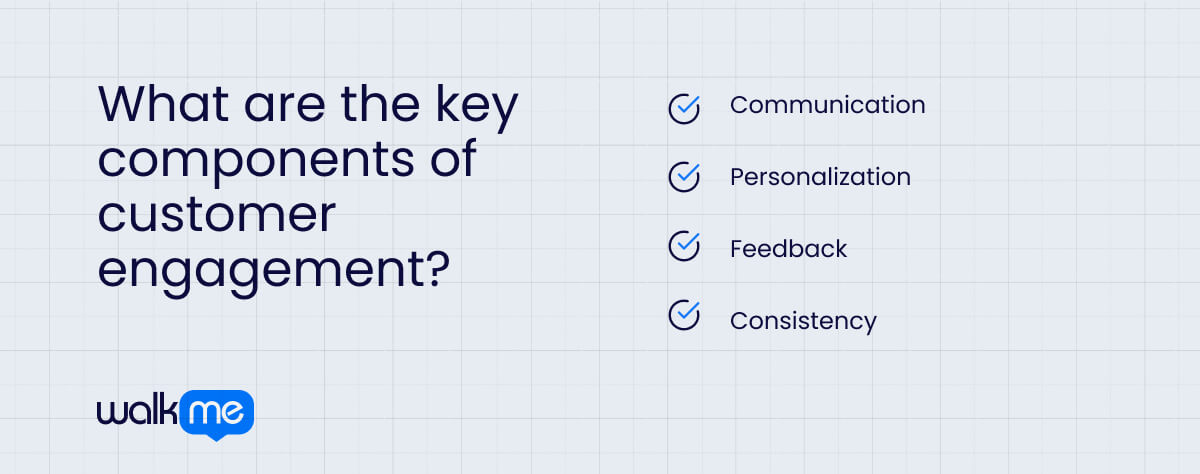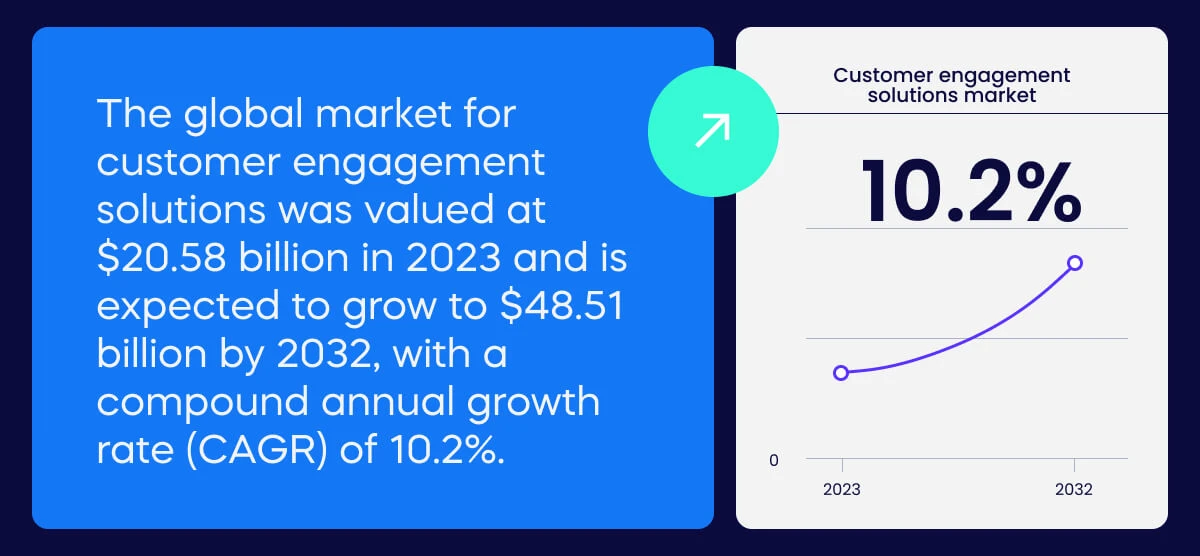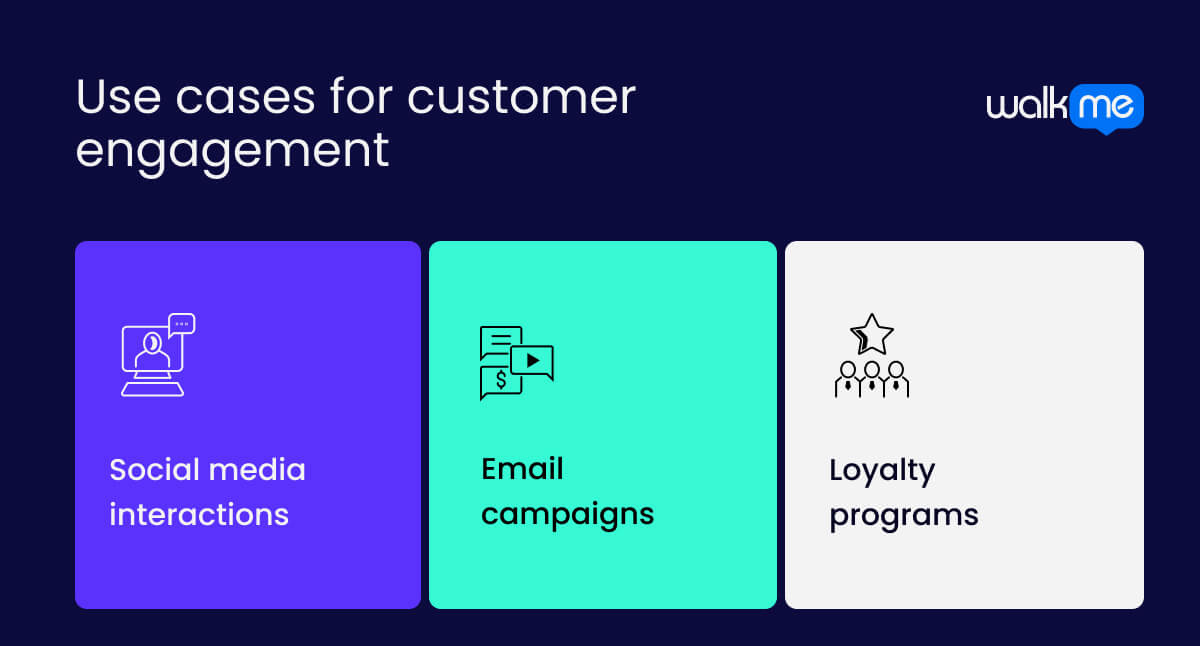What is customer engagement?
Customer engagement is the ongoing interaction between a business and its customers, designed to create a meaningful relationship that extends beyond transactions. Through consistent communication channels—such as social media, email, and customer service—businesses can understand customer preferences, respond to feedback, and improve experiences.

Table of contents
Effective customer engagement drives loyalty and retention. Engaged customers often spend more and recommend the brand to others. Key elements of an engagement strategy include empathy, clarity, and a commitment to delivering a high-quality experience at every touchpoint.
By prioritizing engagement, businesses build trust, encourage repeat purchases, and foster long-term relationships that benefit both parties.
What are the key components of customer engagement?

The global market for customer engagement solutions was valued at $20.58 billion in 2023 and is expected to grow to $48.51 billion by 2032, with a compound annual growth rate (CAGR) of 10.2%.

Knowing the key elements of customer engagement is necessary for creating strong customer relationships. Let’s examine the main components that make customer engagement successful.
Communication
Staying connected through emails, social media, and phone calls keeps customers informed and builds trust, encouraging repeat business.
Personalization
Tailoring messages and offers to individual preferences makes customers feel valued, fostering loyalty and engagement.
Feedback
Listening to customer opinions through surveys and reviews helps businesses improve, showing customers they’re valued and strengthening the brand connection.
Consistency
Providing a reliable, high-quality experience every time builds customer trust and long-term loyalty.
Customer engagement vs. customer experience
Customer engagement and customer experience are about how businesses talk to their customers, but they aren’t quite the same.
- Customer engagement focuses on having fun and interesting conversations that keep customers excited about a brand.
- Customer experience is about making sure every part of the customer’s journey is easy and enjoyable.
Let’s look closer at how these two ideas are different.
| Customer engagement | Customer experience | |
| Definition | How a business talks and connects with its customers. It’s about having fun and interesting conversations. | How customers feel when they use a company’s products or services. It includes everything from when they first learn about the brand to when they buy and use what they bought. |
| Focus | Making strong connections with customers. It wants to keep them interested and excited about the brand. | Making sure every moment is nice and happy for the customers. It looks at how to make them feel good during each part of their journey with the brand. |
| Techniques | Sending special messages, chatting on social media, and giving rewards for coming back. These help make customers want to return. | Easy websites, fast deliveries, and friendly help ensure that customers enjoy their time with the brand. |
| Goals | Create friendships that keep customers coming back. It wants to make them feel excited about the brand. | Give customers a smooth and happy journey. A good experience can make customers smile and tell others about it. |
| Examples of use | A company that sends special emails and offers based on what customers like. It keeps them interested and wanting more. | A brand that has a simple website and fast, helpful service. It makes shopping fun and easy for customers. |
Use cases for customer engagement

Customer engagement is valuable in every industry. For example, 73% of potential customers are more likely to consider an IT vendor that educates them throughout the decision-making process.
Some businesses chat with customers on social media to make them feel special. Others send emails to share news and make customers happy. Some shops have loyalty programs that reward customers for returning to buy more.
Let’s look at three examples to see how customer engagement works.
Social media interactions
Social media interactions help businesses talk to their customers in a fun way. Companies can share pictures, videos, and product updates on platforms like Facebook or Instagram.
Customers who see these posts feel like they are part of the brand. They can also ask questions and share their thoughts.
Having a back-and-forth conversation helps businesses learn what their customers like and want. By making friends online, companies can keep customers happy and make them want to return for more.
Email campaigns
Email campaigns allow businesses to send special messages to their customers. These emails can include fun news about new products, special events, or great sales.
When customers open these emails, they get excited about what they can buy or do. Businesses try to make their emails colorful and engaging so customers will want to read them. It helps keep the customers in the loop and reminds them to check out what the company offers.
Engaging with customers through emails helps make them feel important and excited about the brand.
Loyalty programs
Loyalty programs are like fun games for customers. When they buy something from a store, they can earn points or stickers that add up to prizes. For example, after collecting a certain number of points, they might get a free product or a special discount.
These programs make customers feel special and show them that the business cares about them. Customers who see that they can earn rewards are more likely to keep shopping there.
Loyalty programs help create a friendly connection, making customers want to return again and again.
What are the advantages of customer engagement?
Businesses can increase sales, build trust, and drive innovation by focusing on customer engagement. Let’s explore the key advantages of customer engagement in more detail.
Builds trust
Consistent interaction helps build trust, encouraging customers to return and recommend the brand to others.
Increases loyalty
Engaged customers feel valued and are more likely to remain loyal, leading to repeat purchases and a strong brand relationship.
Improves communication
Open dialogue with customers helps businesses understand needs, leading to better product development and customer satisfaction.
Boosts sales
When customers feel connected to a brand, they’re more likely to make repeat purchases, increasing revenue and growth.
Enhances feedback
Customer engagement provides valuable feedback, helping businesses improve and making customers feel heard.
Creates community
Engagement encourages a sense of community around the brand, encouraging customers to share experiences and connect.
Encourages brand awareness
Satisfied customers spread the word, boosting brand visibility and attracting new audiences.
Drives innovation
Customer insights inspire new products and improvements, keeping the brand relevant and responsive to customer needs.
What are the challenges of customer engagement?
Understanding the challenges of customer engagement helps companies avoid any common pitfalls.
Limited resources
Lack of time, budget, or staff can hinder customer engagement efforts, making it challenging to connect effectively and build lasting relationships.
Inconsistent messages
When messages across social media, emails, and websites are inconsistent, customers are confused, and brand clarity is weakened. Consistent communication helps customers feel confident and connected.
Understanding customer needs
Without effective tools to gather and analyze feedback, businesses struggle to understand customer preferences, missing opportunities to enhance engagement.
Changing wants
As customer needs shift with trends and new products, staying relevant requires ongoing adaptation. Ignoring these changes risks lower engagement and satisfaction.
How can DAPs help with customer engagement?
Digital adoption platforms (DAPs) help businesses connect better with their customers.
When companies use a DAP, it makes it easier for customers to have fun while using their products. These platforms have special tools that show customers how to use things and keep them interested.
Let’s see how DAPs help businesses and customers build stronger connections.
Personalized learning
Customers can learn about products in a way that fits them best. The platform makes special lessons and guides that match each person’s needs. As a result, everyone gets the right information for them. With this type of learning, customers can go at their own speed and feel more comfortable using the product, making it easier for them to have fun.
Feedback collection
DAPs make it simple for businesses to get feedback from customers. They can ask people questions or hear their thoughts after using a product. Feedback like this is really important because it helps companies understand what customers like and what they want to change. With this information, businesses can make improvements, making sure their products are better for everyone.
Easy access to resources
Videos, guides, and answers to common questions are easily accessed by users. When customers have questions or need help, they can find answers easily without searching everywhere. It saves time and makes it easier for them to get the help they need, making their experience much smoother and more fun.
Continuous engagement
Reminders and updates keep customers interested and connected over time. They can let customers know about new features, helpful tips, or important news. Such ongoing support makes customers feel special and valued, which helps them keep using the product and stay loyal to the brand.